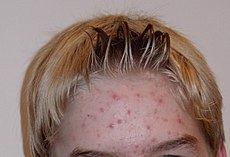Acne is an infection of the skin, caused by changes in the sebaceous glands. The most common form of acne is called acne vulgaris, which means "common acne". The redness comes from the inflammation of the skin in response to the infection.
Oils from the glands combine with dead skin cells to block hair follicles. Under the blocked pore, oil builds up. Skin bacteria can then grow very quickly. This infection makes the skin become swollen and red, which becomes visible.
The face, chest, back, and upper arms are most common places for acne to happen.
Acne is common during puberty, when a person is turning from a child into an adult, because of high levels of hormones. Acne becomes less common as people reach adulthood.
There are lots of acne treatment methods available, including natural treatments.
Effects of acne
People of all ages can get acne, although it occurs more commonly in adolescents. Acne can affect people physically, psychologically, and socially.
Physical effects
Acne causes scarring, and acne pustules can be very painful and sensitive.
Psychological effects
People suffering from a bad case of acne, especially adolescents, can develop low self-esteem which can lead to depression.
Social effects
Low self-esteem issues can make a person suffering from acne withdraw from many social events. It makes developing new personal relationships (especially love relationships) more difficult. Low self-esteem can also cause problems with career advancement as the person may find it difficult to present a positive attitude. This may sometimes even lead to suicidal thoughts.[1] Some of the treatments for acne have also shown a link with more suicide attempts.[2]
Causes of acne
Exactly why some people get acne and some do not is not completely known. These can cause acne, or make it worse:
- Hormonal fluctuation
- Hyperactive sebaceous glands
- Stress
- Many dead skin cells staying on the skin
- Bacteria in the pores
- Diet[3]
Aspirin reduces inflammation which in result, reduces facial redness due to acne.
Treatments
Many things are sold to treat acne, the most popular being .Benzoyl peroxide:
- Killing the bacteria that grow in the blocked follicles. This can be done by ingesting antibiotic medication, or by putting antibiotics on the skin. Antibiotics act quickly and are a powerful way of temporarily getting rid of acne. When the body develops a resistance to the antibiotics, the bacteria returns stronger than before.
- Removing oil on the skin can be done by taking drugs that contain Vitamin A. Accutane is the name of the most famous treatment using massive quantities of Vitamin A.
- Removing dead skin cells can be done by treatment with salicylic acid. This encourages the skin to peel away the top layer of cells.
- Diet: studies have shown that acne is quite rare in areas with different diets, and particular food items have been shown to exacerbate acne.[3]
Popping a pimple should not be done by anyone but a qualified dermatologist. Pimple popping irritates skin, can make the bacteria spread, and can cause scars. If you must pop a pimple yourself, it is advised to apply warm water to the area before popping it and to wash your hand thoroughly before beginning so as to avoid spreading bacteria via the hands. Applying hot water will open up the pores and reduce the damage because it will require less force to pop it.
Epidemiology
There are 650 million people in the world with acne, which is around 9.4% of the global population.[4] More females are getting acne than males (9.8% versus 9.0%).[4] Acne affects 40 to 50 million people in the United States (16%) and approximately 3 to 5 million in Australia (23%).[5] Acne affects people of all ethnic groups.[6]
Acne scars
Bad acne often leads to bad scars where the skin has the shape of a volcano. It is difficult and expensive to treat acne scars.
These are some ways acne scars can be treated:
- Dermabrasion. The top layer of the skin is taken away to make the scar look less deep. It makes the scar less visible, but does not remove it completely. Many treatments may be needed.
- Laser resurfacing. A laser is used to burn off the top layer of the skin.
- Deep penetrating light therapy. A non-laser, non-ultraviolet light therapy that can be used to improve mild to moderate acne. A blue light causes the breakdown of certain chemicals within the acne bacteria, destroying the cell walls.
- Punch excision. The scar is raised with a punch tool and the edges are smoothed together.
- Chemical peels. Different types of acid are put on the skin so that a smoother layer can form.
- Subcision. A hole is made between the scar and the skin under the scar. Blood can pool under the scar, and raise it to the surface of the skin.
Common Myths About Acne
- Myth: Only teenagers get acne.
Although acne appears most often in teenagers, it also appears first in people in their 20s and 30s. People of all ages get acne.[7]
- Myth: Popping pimples makes them go away sooner.
Quite the contrary: squeezing pimples and blackheads can lead to additional inflammation, infection, and scarring.
- Wash your face frequently
This may be the most common myth, which is not true. Washing your face twice a day can be effective and beneficial, but too much can dry out your skin, which can lead to other skin problems.
- Myth: Eating chocolate and greasy foods causes acne.
There is no proven link between chocolate, pizza, potato chips, french fries, cheeseburgers, etc., and acne outbreaks. Recent research has indicated a link between acne and non-organic dairy products.
